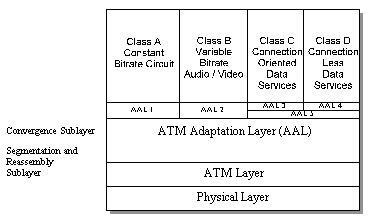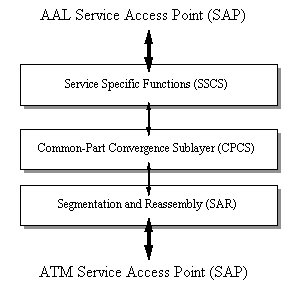AAL - ATM Adaptation Layer
Providing the glue to support the full range of ATM services.
With a promise to support a full range of
applications through a core broadband backbone, ATM has caught
the imagination of a wide spectrum of users. To deliver on this
promise, the ATM Forum and its participants have crafted a
protocol layer flexible enough to provide the mechanisms needed
to adapt the cell transmissions into the necessary higher level
behaviors. ATM has been designed to support applications
including broadband ISDN, carrying multiple synchronous
information channels, as a transfer mechanism for frame-relay and
Switched Multi-Megabit Data Service (SMDS) applications, and
finally as a link-transport mechanism for Local Area Networks.
Each of these types of interfaces requires special mapping
services to operate over the ATM cell structure. The AAL provides
these mappings.
AAL protocols have been defined to support five classes of
service:
- Class X: Control Sigalling - supports the in-band service characteristics.
- Class A: Constant Bit Rate - supports transfer of synchronous circuit services
- Class B: Variable Bit Rate - supports delivery of isochronous services such as variable rate video and voice
- Class C: Connection Oriented data
- Class D: Connectionless Data
These classes of service are mapped to the AAL protocols 0 through 5, referred to as AAL0, AAL1, etc. Figure 1 shows the relationship of the AAL, its major components with the remainder of the ATM protocol stack. Residing above the ATM layer, the AAL protocol elements transfer their information over one or more ATM cells.

Figure 1 - AAL Service Classes & AAL Types
Figure 2 shows the internal components of the AAL. The services provided by each of these components is as follows:
- The Service Specific Functions (SSCS) sublayer provides additional functions and mechanisms that may be required for the a specific service. This layer is not required for all AAL services, and may be represented as a NULL layer.
- The Common Part Convergence Layer (CPCS) operates on the complete AAL frames, providing header and trailer record control as well as ensuring the integrity of delivered information.
- The Segmentation and Reassembly Layer (SAR) converts the CPCS frames to and from ATM cell payload information.
As the information is transferred through each of these layers it takes on a different format. The Service Data Units (SDU) is the representation of data between two service layers; for example, the ATM SDU is presented to the SAR layer for AAL processing. The Interface Data Unit (IDU) is a subcomponent of the SDU; one or more IDUs can contribute to a single SDU. Finally, the familiar term Protocol Data Unit (PDU) is used to represent data between a sublayer and its supporting sublayer. With these options, the way information is named can become confusing.

Figure 2 - AAL Sublayers
AAL-0 NULL AAL
AAL is the simplest and least useful of the AAL service classes is AAL-0. This class of service provides a direct interface into the ATM layer by users. It has been included in the standard to permit equipment designers to disregard the AAL in its entirety. While some had envisioned AAL-0 to useful in supporting control and service messaging, it lacks the guaranteed delivery mechanisms that are critical to many network control functions. For proprietary systems this can be useful. For systems that must operate in open environments, with equipment from multiple vendors, this "feature" should probably be avoided. It doesn't provide much in the way of an aid to interoperability.
AAL-1 Supports Class A Constant Bit Rate Traffic
In support of synchronous networking, AAL-1
provides a constant rate bit-stream between the two ends of an
ATM connection. The data stream is locked to a fixed timing
reference. While providing steady rate transfer is a relatively
simple matter over a single synchronous interface, the
asynchronous nature of ATM provides a significant challenge.
Variations in a network's ability to deliver ATM traffic can
result in significant jitter that impedes orderly reassembly of
the synchronous traffic stream. Figure 3 shows the format of the
AAL-1
SAR-PDU, that is sent over a single ATM cell. AAL-1 PDU fields
include the Sequence Number that consists of a three-bit
repeating sequence number, and a "CS-indication" bit, a
4-bit Sequence Number Protection (SNP) field that protects
against sequence number errors, and a 47-octet payload.
Typically, this payload field is intended to be filled, however,
it can be partially used based on prenegotiated operation.

Figure 3 - AAL-1 Cell Format
Some of the most interesting aspects of AAL-1 are involved in clock recovery. Send too much information and data must be dropped. Send too little (too slow), and information must be padded. Two general approaches to resolving these issues have been proposed, Synchronous Residual Time Stamp where the clocks on both ends of a network connection are synchronized, and Adaptive Clock, in which the receiver adjusts the speed of its clock on the basis of the amount of information available in its receive buffers.
AAL-2 Variable Rate Synchronous Service
AAL-2 is based on the assumption that some forms of isochronous information can be represented in a multiple data rate format. For example, the rate of some video compression techniques can vary on the basis of the complexity and rate of change of moving images. While this portion of the standard has been highlighted, it is absent from the published standards.
AAL-3/4 End-To-End Data Transport
Based on the SMDS standard, AAL-3/4 provides data transport services for both connection and connectionless data. These services correspond to Class C and Class D data. Unlike AAL-0 and AAL-1, AAL-3/4 includes a range of service options. Information is transferred in either message or streaming mode. Optional delivery assurance techniques include discarding faulty SDUs, end-to-end data recovery, and delivery of all SDUs regardless of their integrity. Assured transmission through retransmission is discussed in the standards, but is not fully specified. Non-assured transmission is supported in the standard, with options to deliver or discard faulty SDUs. Typically, it is most useful to discard faulty SDUs. Delivery of unreliable information is typically something to avoid. Several logical AAL connections can be multiplexed over a single ATM Virtual Circuit (VC). Finally, AAL-3/4 provides a capability to support multipoint delivery of information from a single source.
To support this set of services, the AAL-3/4 architecture is considerably more involved than the other AAL protocols. Active processing is performed by both the CPCS and SAR layers to provide additional functions. Processing steps include receipt of the User data frame to AAL, CPCS formatting of the AAL-PDU for transmission to the destination, followed by forwarding of the CPCS-PDU to the SAR layer for segmentation into a set of 44-byte PDUs for transmission (with 3 octets of SAR control information) over the ATM layer. On receipt of the ATM PDU, the opposite process ensues, with the SAR reassembling the stream of SAR-PDUs into a single CPCS-PDU, and delivering the received CPCS-PDU to the CPCS for final processing and delivery of information to the user. A summary of these processes follows.
The AAL-3/4 CPCS is responsible for managing the integrity of AAL-3/4 information. It additionally pads the information data-block size to an even multiple of 4 octets, simplifying protocol processing by CPUs such as the Motorola 680x0 series that are popular in telecommunications systems. Figure 4 shows the format of the CPCS-PDU. The fields of the PDU and their use are:
- CPI - Common Part Indicator: Acts as a protocol identifier that defines how the remaining fields of the PDU are to be processed. At this point, it is largely a placeholder to support future changes to the protocol, the CPI is specified to be always zero by ITU-T I.363.
- Btag - Beginning Tag. This value is used to determine whether or not the CPCS-PDU has been properly delivered. When the CPCS-PDU is constructed, the same value is entered into both the Btag and Etag fields. If a reassembled CPCS-PDU is received with these values being different, the PDU is assumed to have been corrupted. The tag value is incremented (with a wrap at all ones) as each PDU is constructed.
- BASize - Buffer Allocation Size Indication. Tells the receiver the amount of buffer space to allocate to process the PDU. This value is equal-to or greater than the PDU size.
- Pad - Ensures that the PDU is a multiple of 4 octets in length. This simplifies processing of the PDU in 32-bit chunks.
- AL - Alignment Field. This is unused pad space with the sole purpose of padding the trailer to 4-octets
- Etag - End Tag. Matches the beginning tag. Used for data integrity verification
- Length - Field Length. Specifies theactual length of the CPCS-PDU (in octets when CPI=0). As the SAR is responsible for framing the data, this is provided to support additional error checking.

Figure 4 - AAL-3/4 CPCS PDU Format
The Segmentation and Reassembly Sublayer manages the fragmentation and reassembly of the AAL-3/4 CPCS-PDUs into payload information that can be carried by the ATM cells. The format of the SAR-PDU is shown in Figure 5. The SAR-PDU fields and there application are as follows:
- ST - Segment Type (2-bits) defines where the segment belongs in the SAR-SDU (essentially the CPCS-PDU). Possible values include: (10) beginning of the message, (00) continuation of the message, (01) end of the message, and (11) single segment message.
- SN - Sequence Number (4-bits). Used to ensure the in-order delivery of segments.
- MID - Multiplexing Identification Field. (10-bits) Provides compatibility with SMDS, this field carries multiplex channel identification, allowing for the transmission of multiple channels of information over a single ATM VC.
- Payload - (44-octets) the segment of the CPCS-PDU information to be transferred within this cell.
- LI - length Indication. (6 bits) Identifies the amount of information in the payload portion of the cell. Only the last cell in a transmission should have less than 44 octets of information. Therefore, this value will be 44 for all segments with the exception of the end-of-message segment, in which case it is an even multiple of 4 between 4 and 44 (remember the CPCS padding).
- CRC - cyclic redundancy check (10-bits). Calculated over the complete SAR-PDU with the exception of the CRC field.
![]()
Figure 5 - SAR-PDU Format
AAL-5 Simple Data Transfer
While the AAL-3/4 provides a rich set of services, it does so at the expense of additional protocol overhead and processing. AAL-5, originally coined the Simple and Efficient Adaptation Layer (SEAL) was designed to provide similar services at lower overhead. This AAL takes advantage of the ATM End of Message (EOM) flag to signal the end of a single message. Significant overhead is elimated by removing the SAR header and trailer. Processing involves construction of a CPCS-PDU (shown in Figure 6) that can carry between 1 and 65535 octets, that is segmented into a series of 48 octet SAR-PDUs for ATM transmission.

Figure 6 - AAL-5 CPCS-PDU
Components of the AAL-5 CPCS-PDU are:
- Pad - rounds the data length to an even multiple of 4-octets.
- UU - user to user indication. Used to pass information between CPCS users.
- CPI - always zero, and provides boundary alignment
- Length - indicates the number of legitimate octets within the PDU.
- CRC (32-bits).
Through services provided by the AAL protocols, user applications are able to realize the full scope of services promised by ATM.